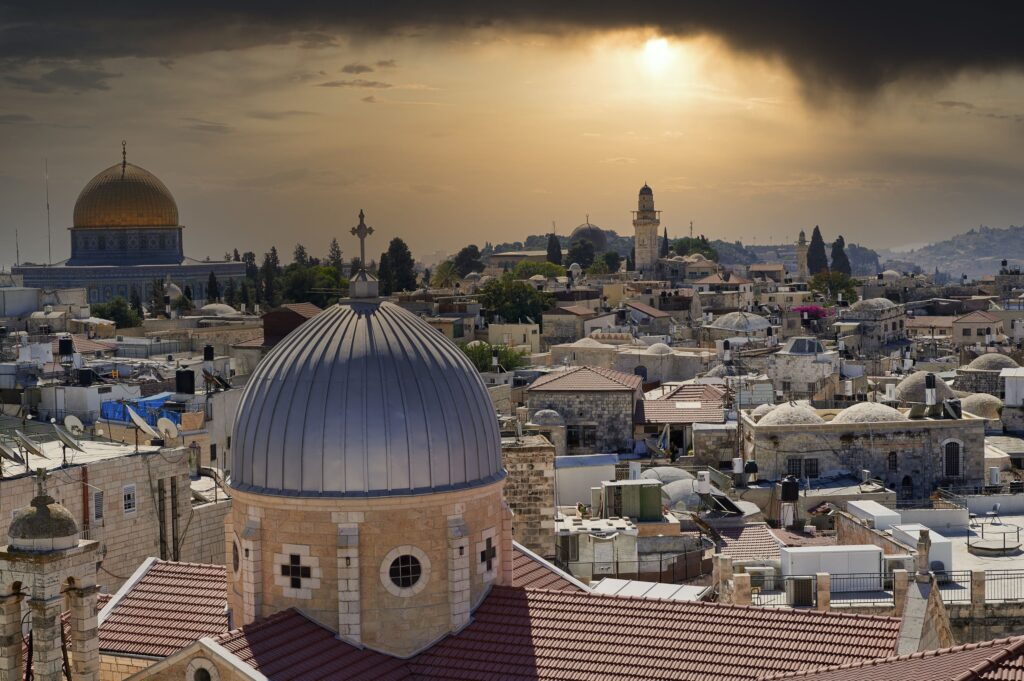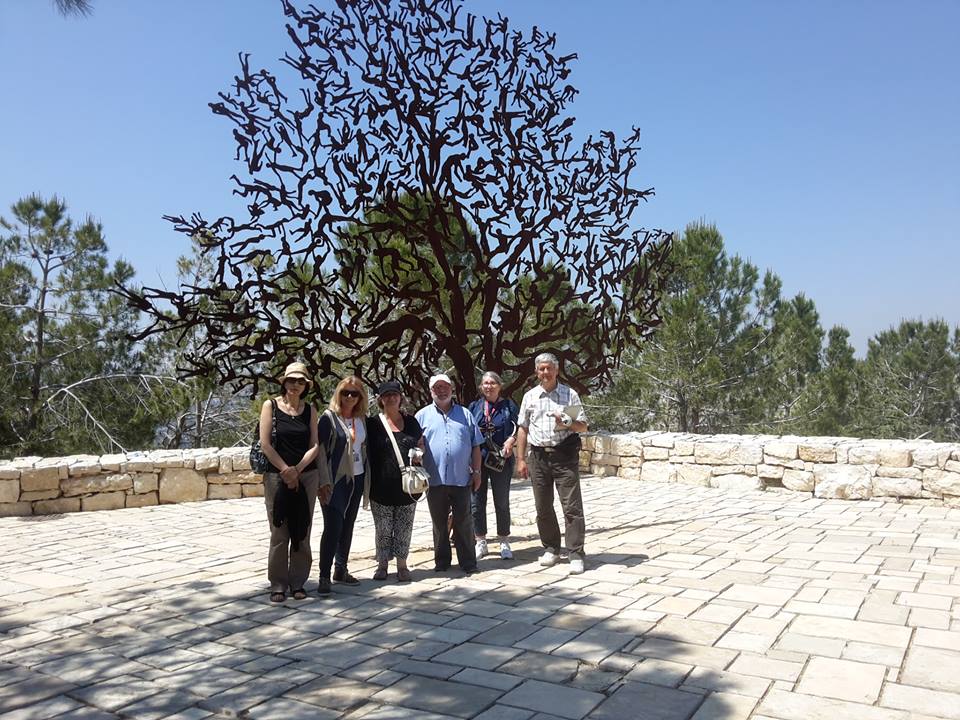Things to do In Jerusalem

The Old City of Jerusalem
Surrounded by walls, The Old City of Jerusalem, one of the oldest continuously inhabited cities, is a place of deep religious, historical, and cultural significance that attracts visitors and pilgrims from around the world. The coexistence of different religious communities within adds to its unique atmosphere and importance.
Divided into four quarters: the Jewish Quarter, the Muslim Quarter, the Christian Quarter and the Armenian Quarter – each has its own distinct character and religious sites.
One of the most sacred sites in Judaism, The Western Wall, also known as the Wailing Wall, is located in the Jewish Quarter. It is a remnant of the retaining wall that once supported the Second Temple, destroyed by the Romans in 70 CE.
The Church of the Holy Sepulchre, a Christian church located in the Christian Quarter, is revered as the site of the crucifixion, burial, and resurrection of Jesus Christ. It is a major pilgrimage destination for Christians.
The Dome of the Rock and Al-Aqsa Mosque are two significant Islamic structures on the Temple Mount, considered the third holiest site in Islam.
The smallest quarter of the Old City is the Armenian Quarter, home to some 2,500 Armenians, an ancient community who have resided in the city for more than 2,000 years. The Old City has a rich history, reflecting the influence of various civilizations over the centuries, and its vibrant bazaars, characterized by narrow winding streets, hold a unique atmosphere. The markets, or souks, offer a variety of goods, including traditional crafts, spices, and religious artefacts.

The Mount of Olives
Visiting the Mount of Olives in Jerusalem is a journey through history, spirituality, and breathtaking views that offer a unique perspective of the holy city. Situated to the east of the Old City, this iconic mountain holds immense religious significance for Judaism, Christianity, and Islam.
As you ascend the Mount of Olives, the air becomes infused with a sense of sacredness. The name itself is derived from the olive trees that once covered its slopes, providing an atmospheric backdrop that has witnessed centuries of religious events. The olive tree, symbolizing peace and spirituality, adds a serene touch to the landscape.
One of the most notable attractions at the foot of the Mount of Olives is the Garden of Gethsemane. This ancient olive grove is believed to be the site where Jesus prayed on the night of his betrayal, making it a crucial pilgrimage site for Christians. The gnarled and ancient olive trees that populate the garden evoke a sense of solemnity and reflection.
Also located on the western slope is the Jewish cemetery, the Russian Orthodox Church of Mary Magdalene, the Tomb of the Prophets and Church of Dominus Flevit, while at the summit, the panoramic views of Jerusalem unfold before you. The Old City, with its labyrinthine streets and historic landmarks, lies nestled in the valley below. The Dome of the Rock glistens in the distance, while the ancient walls of Jerusalem reveal layers of history that have shaped the city over millennia.

The Israel Museum
The Israel Museum – located in Jerusalem, is the largest cultural institution in the State of Israel, founded in 1965 and situated on a 20-acre campus near the Knesset (the Israeli parliament), the Supreme Court, and the Hebrew University of Jerusalem.
Renowned for its diverse and extensive collections, including a wide range of art, artifacts, and archaeological finds, it is a vital foundation for the preservation and promotion of Israel’s cultural heritage, providing visitors with a comprehensive understanding of the region’s history and artistic achievements.
The museum features outdoor sculpture gardens, providing a peaceful space for visitors to enjoy art and nature, while within the complex you can find The Shrine of the Book, housing the Dead Sea Scrolls, a collection of Jewish texts that date back to the Second Temple period.
The Art Wing features an impressive collection of European, modern, and contemporary art, including works by artists such as Chagall, Picasso and Van Gogh.
In the Archaeology Wing visitors can explore archaeological artifacts from the Holy Land, ranging from prehistoric times to the Ottoman period providing insights into the rich history of the region. The Jewish Art and Life Wing section showcases objects related to Jewish culture and tradition, including items from the Jewish diaspora, ritual objects, and ceremonial art and for younger visitors the Youth Wing offers interactive exhibits and activities designed to engage children and teach them about art and culture.

Mahane Yehuda Market
If you want to explore the city of Jerusalem beyond its historical and religious sites, Mahane Yehuda Market is one of Jerusalem’s most vibrant and popular open-air markets, located in the heart of the city, with a rich history dating back to the late 19th century, which has become a symbol of Jerusalem’s dynamic atmosphere.
Often referred to simply as the “Shuk”, it is characterized by narrow alleys and lanes that are filled with a colorful array of stalls and shops and is known for its diversity, both in terms of the products it offers and the people who visit.
A wide range of goods can be found, including fresh produce, spices, baked goods, meats, fish, dairy products, sweets, and more.
In recent years, Mahane Yehuda has evolved into a culinary hotspot. Alongside the traditional market stalls, you’ll find trendy cafes, restaurants and bars, which come alive in the evenings, offering a lively nightlife scene.
The market is generally busy throughout the week, but especially on Fridays as people prepare for the Sabbath and in the evening, when it transforms into a nightlife destination.

The Tower of David
Also known as the Jerusalem Citadel, the Tower of David is located next to the Jaffa Gate entrance to the Old City of Jerusalem. The tower has a rich history, dating back to the Hasmonean period, around the 2nd century BCE and has been significantly modified, rebuilt, and expanded by subsequent rulers, including Herod the Great who added three large towers and a palace complex, as well as the Islamic caliphs, where it served both military and ceremonial functions and was part of the city’s defenses.
Today, the Tower of David serves as a museum and cultural center, showcasing the history of Jerusalem and the various civilizations that have influenced the city over the centuries.
Visitors can climb to the top of the tower and walk along the walls to enjoy panoramic views of the Old City of Jerusalem, including its historic sites, landmarks, and the surrounding landscape. The ancient stones come to life each night under the open sky, telling the story of Jerusalem. In 2 night experiences, images are screened on the citadel walls including video, sound and lighting, beautiful music, and expansive, multi-colored visuals, where against the backdrop of the Old City you can see kings rise and fall, holy buildings built, armies fighting, and cultures, religions and myths blossoming.

Yad Vashem
Yad Vashem is the official museum and memorial in Jerusalem, dedicated to the memory of the Holocaust. Taken from the Bible, the term “Yad Vashem” means “a place and a name,” emphasizing the importance of remembering the individuals who perished in the Holocaust and ensuring that their names are not forgotten.
Established in 1953 by the Israeli government as the national institution for the documentation, research, education, and commemoration of the Holocaust, the memorial complex is situated on the western slope of Mount Herzl, overlooking the Hinnom Valley.
The museum itself provides a chronological account from the rise of the Nazis to power in Germany to the liberation of the concentration camps, using a variety of multimedia displays, artifacts, testimonies, and documents to convey the history of the Holocaust.
Among its other exhibits are the Hall of Names, a poignant memorial dedicated to preserving the memory of each individual victim; the Children’s Memorial, a dark cavernous space illuminated by the light of thousands of memorial candles, each one representing a child who perished and the Righteous Among the Nations, an avenue honoring non-Jews who risked their lives to save Jews during the Holocaust Visiting Yad Vashem is a powerful and emotional experience, and it serves as a solemn reminder of the atrocities committed during the Holocaust and the importance of preserving the memory of the victims.
Ein Karem
A picturesque neighborhood nestled in the hills on the western outskirts of Jerusalem, Ein Karem is a place that seamlessly blends history, spirituality, and natural beauty. As you approach Ein Karem, the first thing that strikes you is the serene and lush landscape. The neighborhood is surrounded by hills and valleys and the air is filled with the scent of blooming flowers and the sound of birdsong adding to the tranquility of the area.
According to tradition, Ein Karem is the birthplace of John the Baptist, and Mary, the mother of Jesus, is believed to have visited the home of her relative Elizabeth here. The Church of the Visitation, with its striking architecture and interior, adorned with beautiful mosaics and paintings depicting scenes from the biblical story, is perched on a hill overlooking the village and commemorates this visitation.
As you wander through the neighborhood, you can visit the Church of St. John the Baptist, which is built over the traditional site of John the Baptist’s birth. The church’s courtyard is a peaceful spot to sit and reflect, surrounded by ancient stone walls and the quiet ambiance of the area.
Strolling through the narrow, winding streets of Ein Karem, you’ll encounter charming stone houses, artisan workshops, and cozy cafes. The local arts and crafts scene is thriving, with many artists calling Ein Karem home. You can explore galleries showcasing a diverse range of paintings, sculptures, and handcrafted jewelry, providing a unique opportunity to take home a piece of local art. Ein Karem is not just a place of historical and religious significance; it’s also a culinary delight. Cafes and restaurants offer a variety of local and international dishes, and many of them have outdoor seating areas with stunning views of the surrounding hills. It’s the perfect setting to savor a meal while taking in the beauty of the landscape.
More Articles: